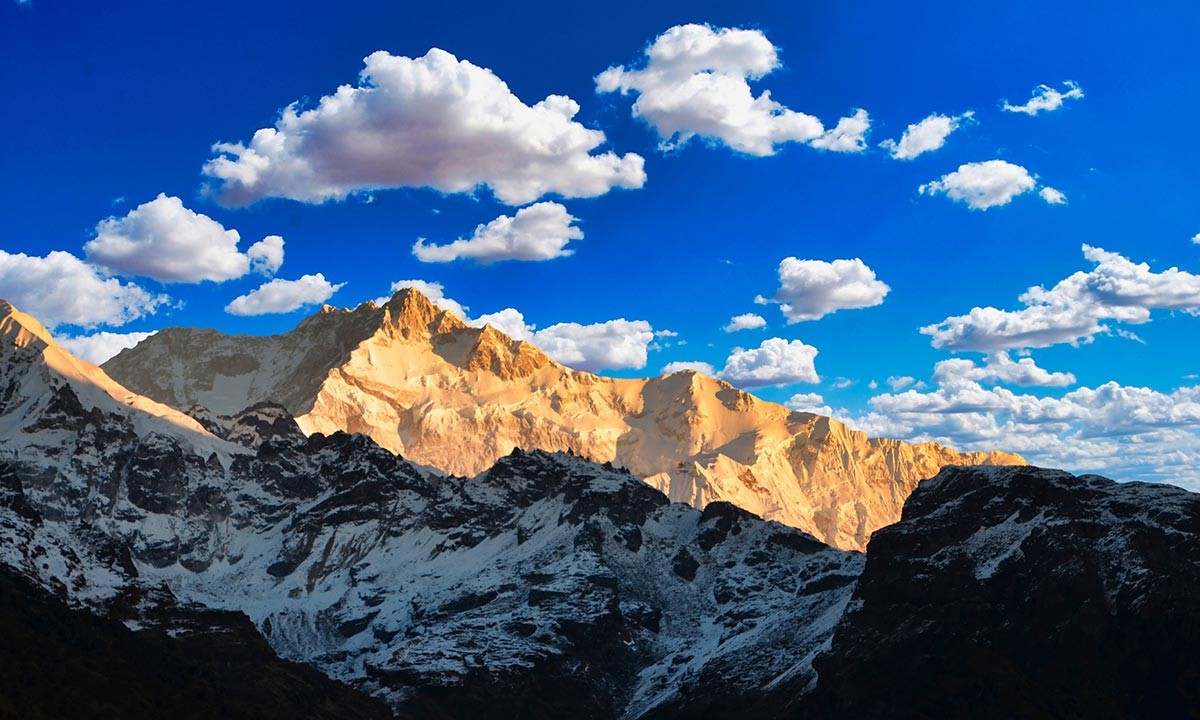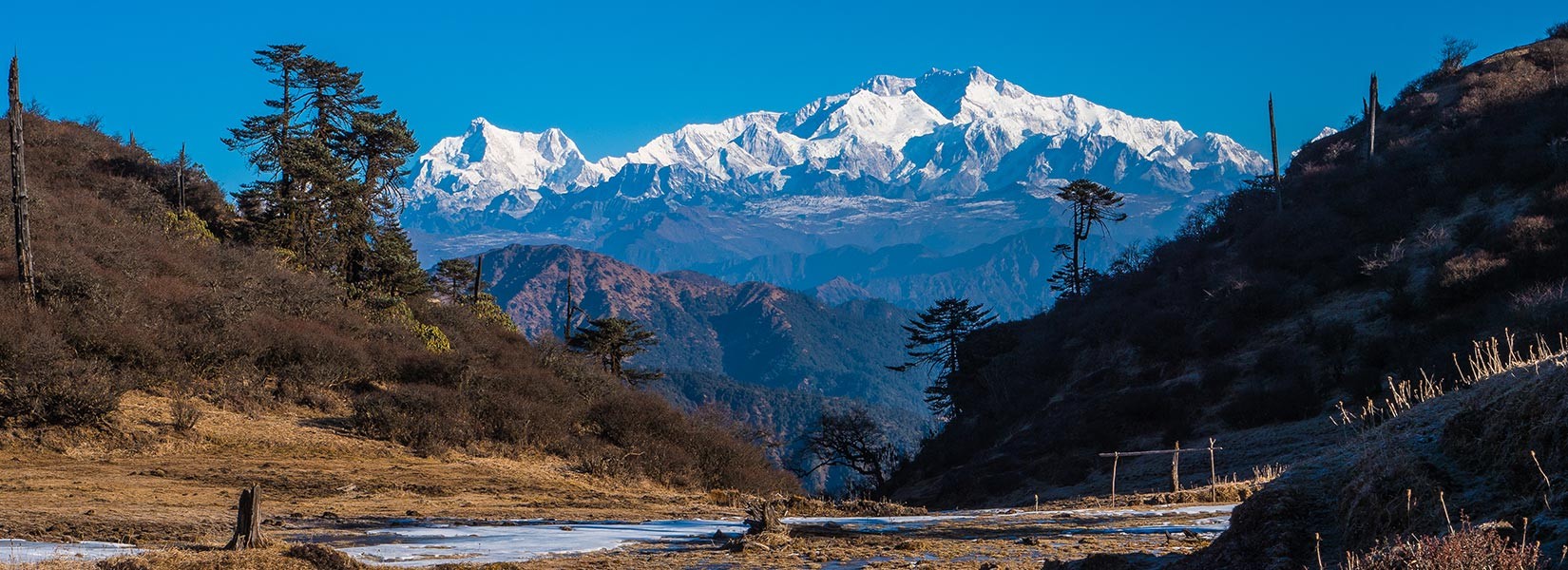 Kanchenjunga Trek is an incredible journey to the foothills of Mt Kanchenjunga and heavenly Eastern Nepal. Being the third highest peak in the world, Mt Kanchenjunga (8,586m) has been dragging mountaineers and trekkers from all around the globe. It is no surprise that the majestic peak also attracts you.
Kanchenjunga Trek is an incredible journey to the foothills of Mt Kanchenjunga and heavenly Eastern Nepal. Being the third highest peak in the world, Mt Kanchenjunga (8,586m) has been dragging mountaineers and trekkers from all around the globe. It is no surprise that the majestic peak also attracts you.
Kanchenjunga has five peaks and is shared by India and Nepal. The Kanchenjunga Main, Central, and South lie on the border, and the Kangbachen and Kanchenjunga west lie entirely in Nepal. This trek will ultimately be on Nepal’s side. You will get to see and explore the beauty of the land of Nepal. Read detail on Where Kanchenjunga is Located?
This adventure to the home of Kanchenjunga is an excursion of 18 days. Beginning in Kathmandu, Nepal’s capital, the trip will progress through the unexplored side of Nepal. It is a trek for avid trekkers who like to explore the world's tranquil, remote, and off-the-beaten corners.
The explorers of the British Expedition in May 1995 explored a trail to reach
Oktang (Kanchenjunga South Base Camp) and Yarlung Glacier. And this Kanchenjunga Trek follows the same route. You will walk through the exciting path to reach Kanchenjunga South Base Camp (4,780m) and Kanchenjunga North Base Camp(5,190m). Check more on how to reach Kanchenjunga.
The whole trek is a sheer experience for trekkers. Starting the tour with a scenic flight and drive, trekkers reach the beginning point of the walk. Then, trekkers travel across beautiful villages of various ethnic people in the region. The tour offers you a look into their lifestyle and culture. As the trek progresses, trekkers traverse via the lush Kanchenjunga Conservation Area, an affluent site of flora and fauna.
Many rivers, streams, waterfalls, ponds, and glaciers come along on this walk. The best thing about the trek is good things keep coming at you. Scenic mountain passes and magnificent snow-clad peaks are just some of the good things. The notable peaks of the trek are Kanchenjunga series, Yalung Kang, Kirat Chuli, Kabru, Pathibhara, Gimigela, Doma, Faktanglung and more. Likewise, the important mountain passes of the trek are Miring La, Selele Pass, and Tamo La. You will touch numerous other attractive hilltops and ridges.
As said earlier, Kanchenjunga Trek is a complete trekking package. It is ranked as a moderate to difficult trek; thus, it is only for avid and experienced trekkers. It requires good preparation, experience, and immense enthusiasm to do this adventure. If you feel like you have all of them, we are here to help you on unraveling this journey.
Why Choose Kanchenjunga Trek?
Peaceful Trail
The home of Kanchenjunga is not a crowded region. It is a tranquil region that only attracts peace lovers. Unlike Everest Trail or Annapurna Trail, Kanchenjunga Trail lets you peacefully talk to yourself and nature.
Full of natural adventures
Kanchenjunga Trek is a sublime trail for adventure lovers. The not-so-developed path has all sorts of excitement. Glaciers, mountain passes, uphills, dense woods, endangered species, rivers, mountain base camps, and more. What you are going to get is never sure on this trek.
Novel experience
Kanchenjunga Base Camp Trek is about exploring the unexplored side of Nepal. This part of Nepal is not experienced by many. The beauty and madness of the trek are forbidden things for the world. This is the trek if you want to share something novel.
Culture and Lifestyle
Nepal is a country rich in culture. And Kanchenjunga Region proves that quite nicely. The trek embarks you on the journey to experience the mixture of Tibetan, Indian, and Nepalese cultures and living styles. The region’s higher parts are remote and less developed. You can learn something on this trek that you cannot learn elsewhere.
Mountain Vistas
Kanchenjunga Trek is also about awe-inspiring mountains. The trek consists of multiple mountain shows at various mountain passes, hilltops, ridges, and base camps. You’ll have some of the best mountain sights of your life. Along with the third highest peak in the world, you will catch pictures of Mt Jannu, Mera Peak, Rathong Peak, Janu Peak, and many more.
When is the best time for Kanchenjunga Trek?
When to walk Kanchenjunga Trek? Well, the answer is simple. Do it when everything is alright. That would be the Autumn and Spring seasons, the best times to explore Nepal’s higher corners. The seasons are just perfect for venturing into the Kanchenjunga region.
Autumn(September, October, November) is a stable time to visit eastern Nepal, the home of Mt Kanchenjunga. It is dry weather with minimal precipitation level. There are fewer chances of rainfall and snowfall during Autumn. You can glance at landscapes, valleys, and peaks without any disturbance. The weather is also quite ideal and warm. Plus, it is the time of grand festivals in Nepal.
Likewise, Spring(March to May) is another ideal time for Kanchenjunga Trekking. It is the season of colorful flowers and surroundings. Everything is blossoming in this season, especially Rhododendron flowers. Also, the temperature is mild and bearable except during night and morning hours. The precipitation level is shallow, meaning fewer rainfall chances and a dry trail.
How Difficult is the Kanchenjunga Trek
Kanchenjunga Trek is not for newbies. It is one route that takes you to the wild, remote, and high parts of Nepal. The trek is long and challenging as you have to spare 21 days for the entire trip. Kanchenjunga Trekking is rated moderate to difficult for its high-altitude trekking and trail nature. Check more on Kanchenjunga trek difficulty.
The trek is an adventurous journey through the rugged, remote, isolated region. The walk begins from an altitude of 900m and reaches a pinpoint of 5,143m. You will cross numerous uphills, ridges, glaciers, rapid descents, and mountain passes. On average, you must trek for 6-8 hours and 10-12kms. Some of the days are even longer.
Trekkers with enough experience, expertise, and preparation can only overcome this trek. Thus, Kanchenjunga Trekking is not a trek for beginners. It is about the ultimate trekking experience in the Himalayas. The conditions can be totally against you at times. You have to sleep in tented camps on some days. Choose this trek only if you can endure such situations. Be well prepared!
Can you do the trek?
You can do the Kanchenjunga trek. However, you must be in good shape, have enough experience, and have excellent preparation. As said in the earlier section, Kanchenjunga Trek is a rough and demanding journey for beginners.
The trek involves a strenuous walk, long days, high altitude trekking, unfavorable weather conditions, and remote circumstances. We do not think a beginner with no prior trekking experience in the mountains can ever complete this trek. We might be wrong, but it is strictly not for novices.
Therefore, if you have walked in the mountains before, experienced high altitudes, and know how to deal with mountains, you are the right fit for this adventure. You also need to do some good cardio and strength training. You got the answer, right?
How to prepare for Kanchenjunga Trek
Kanchenjunga Trek needs some trekking to complete it. The trekker has to be well prepared before the trek date. How they can prepare is confusing. You can focus on Cardiovascular training, Strength Training, and mental training.
Firstly, cardiovascular training is a must for any high-altitude trek. The training makes your lungs and overall cardio system excellent. With a good cardiovascular level, your body can easily supply oxygen to your body, even in high areas. For that reason, cardio training is the first to look at while preparing for Kanchenjunga Trek. Some popular cardio exercises include running, jogging, hiking, cycling, swimming, and hill climbing. Make a strict plan of 2-3 months and act on it.
Likewise, Kanchenjunga Trekking demands trekking with solid strength. Strength will be required for walking, climbing, and crossing the trek's rugged, steep, and downhill. As you know, you have to walk for 7-8 hours on demanding trails. Thus, do workouts that make your back, shoulder, arm, feet, and entire body. Focus on building stamina and endurance level. The training can include pull-ups, bridges, squats, deadlifts, biceps curls, planks, etc.
Lastly, you need a mind that does not easily give up. A committed mentality is a must for an arduous journey. With such a mentality, you will push yourself on the trek when you don't feel like it.
In this way, you can prepare for Kanchenjunga Trek. Leave everything else to us; we will manage!
Is this trek for Beginners?
No, this trek is not for beginners. Rated as Moderate to Difficult Trek, Kanchenjunga Trek is strictly for experienced and well-prepared trekkers. The tour is a long journey of 21 days in which you have to cross several high mountain passes, reach two base camps, and more. A beginner will have huge problems on this trek. Thus, this trek is not for beginners but experienced trekkers.
Why is Acclimatization necessary?
Acclimatization is a process of becoming accustomed to something new. On Kanchenjunga Trek, the high areas and their altitudes will be unique for you and your lungs. In such a case, your body will need some to get used to the new conditions.
With time, your body will know the high areas and become friendly.
Otherwise, the altitude can get against you, and you might incur altitude sickness. Therefore, acclimatization is necessary for any high-altitude trek. It is the best way to avoid mountain sickness.
Outline Itinerary
Day 01: Fly to Bhadrapur and Drive to Phidim (1,365 m) - 04 hrs
Day 02: Drive to Taplejung and Trek to Sinuwa (980m) - 6 hrs
Day 03: Sinuwa to Tapethok (1,380m)
Day 04: Tapethok to Amjilosa (2,310m)
Day 05: Amjilosa to Gyabla (2,730m)
Day 06: Gyabla to Ghunsa (3,595m)
Day 07: Acclimatization Day at Ghunsa
Day 08: Ghunsa to Khambachen (4,000 m) - 06 hrs
Day 09: Khambachen to Lhonak (4,780 m) - 06 hrs
Day 10: Trek to Kanchenjunga North Base Camp (5,065 m) return back to Lhonak
Day 11: Lhonak to Khambachen (4,050m)
Day 12: Khambachen to Phaley (3240 m)
Day 13: Phaley to Amjilosa (2,310m)
Day 14: Amjilosa to Tapethok (1,380m)
Day 15: Tapethok to Sinuwa (980m)
Day 16: Sinuwa to Taplejung
Day 17: Drive to Bhadrapur - 03 hrs drive
Day 18: Fly back to Kathmandu






